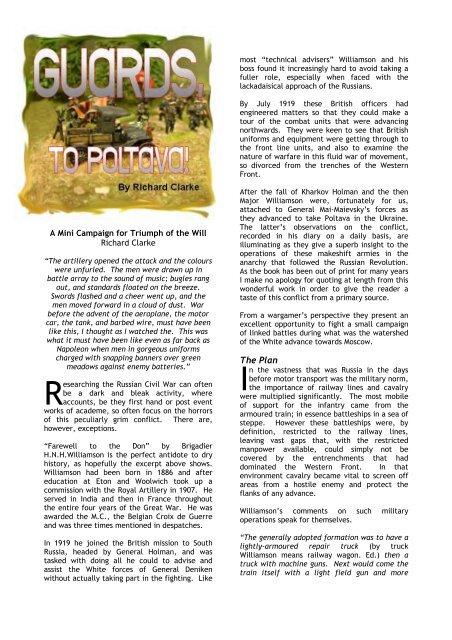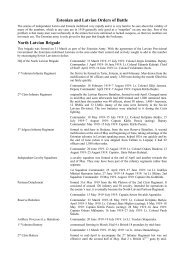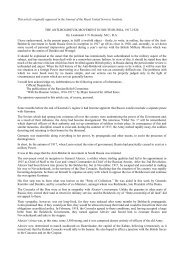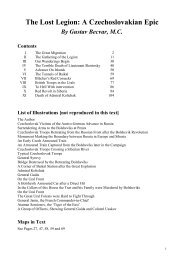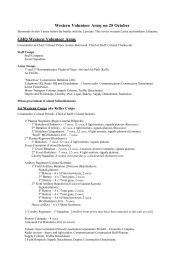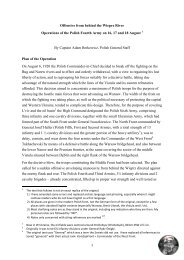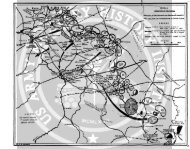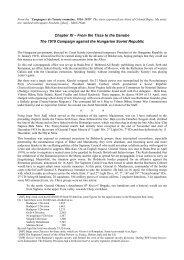You also want an ePaper? Increase the reach of your titles
YUMPU automatically turns print PDFs into web optimized ePapers that Google loves.
most “technical advisers” Williamson and his<br />
boss found it increasingly hard <strong>to</strong> avoid taking a<br />
fuller role, especially when faced with the<br />
lackadaisical approach of the Russians.<br />
By July 1919 these British officers had<br />
engineered matters so that they could make a<br />
<strong>to</strong>ur of the combat units that were advancing<br />
northwards. They were keen <strong>to</strong> see that British<br />
uniforms and equipment were getting through <strong>to</strong><br />
the front line units, and also <strong>to</strong> examine the<br />
nature of warfare in this fluid war of movement,<br />
so divorced from the trenches of the Western<br />
Front.<br />
A Mini Campaign for Triumph of the Will<br />
Richard Clarke<br />
“The artillery opened the attack and the colours<br />
were unfurled. The men were drawn up in<br />
battle array <strong>to</strong> the sound of music; bugles rang<br />
out, and standards floated on the breeze.<br />
Swords flashed and a cheer went up, and the<br />
men moved forward in a cloud of dust. War<br />
before the advent of the aeroplane, the mo<strong>to</strong>r<br />
car, the tank, and barbed wire, must have been<br />
like this, I thought as I watched the. This was<br />
what it must have been like even as far back as<br />
Napoleon when men in gorgeous uniforms<br />
charged with snapping banners over green<br />
meadows against enemy batteries.”<br />
Researching the Russian Civil War can often<br />
be a dark and bleak activity, where<br />
accounts, be they first hand or post event<br />
works of academe, so often focus on the horrors<br />
of this peculiarly grim conflict. There are,<br />
however, exceptions.<br />
“Farewell <strong>to</strong> the Don” by Brigadier<br />
H.N.H.Williamson is the perfect antidote <strong>to</strong> dry<br />
his<strong>to</strong>ry, as hopefully the excerpt above shows.<br />
Williamson had been born in 1886 and after<br />
education at E<strong>to</strong>n and Woolwich <strong>to</strong>ok up a<br />
commission with the Royal Artillery in 1907. He<br />
served in India and then in France throughout<br />
the entire four years of the Great War. He was<br />
awarded the M.C., the Belgian Croix de Guerre<br />
and was three times mentioned in despatches.<br />
In 1919 he joined the British mission <strong>to</strong> South<br />
Russia, headed by General Holman, and was<br />
tasked with doing all he could <strong>to</strong> advise and<br />
assist the White forces of General Deniken<br />
without actually taking part in the fighting. Like<br />
After the fall of Kharkov Holman and the then<br />
Major Williamson were, fortunately for us,<br />
attached <strong>to</strong> General Mai-Maievsky’s forces as<br />
they advanced <strong>to</strong> take <strong>Poltava</strong> in the Ukraine.<br />
The latter’s observations on the conflict,<br />
recorded in his diary on a daily basis, are<br />
illuminating as they give a superb insight <strong>to</strong> the<br />
operations of these makeshift armies in the<br />
anarchy that followed the Russian Revolution.<br />
As the book has been out of print for many years<br />
I make no apology for quoting at length from this<br />
wonderful work in order <strong>to</strong> give the reader a<br />
taste of this conflict from a primary source.<br />
From a wargamer’s perspective they present an<br />
excellent opportunity <strong>to</strong> fight a small campaign<br />
of linked battles during what was the watershed<br />
of the White advance <strong>to</strong>wards Moscow.<br />
The Plan<br />
In the vastness that was Russia in the days<br />
before mo<strong>to</strong>r transport was the military norm,<br />
the importance of railway lines and cavalry<br />
were multiplied significantly. The most mobile<br />
of support for the infantry came from the<br />
armoured train; in essence battleships in a sea of<br />
steppe. However these battleships were, by<br />
definition, restricted <strong>to</strong> the railway lines,<br />
leaving vast gaps that, with the restricted<br />
manpower available, could simply not be<br />
covered by the entrenchments that had<br />
dominated the Western Front. In that<br />
environment cavalry became vital <strong>to</strong> screen off<br />
areas from a hostile enemy and protect the<br />
flanks of any advance.<br />
Williamson’s comments on such military<br />
operations speak for themselves.<br />
“The generally adopted formation was <strong>to</strong> have a<br />
lightly-armoured repair truck (by truck<br />
Williamson means railway wagon. Ed.) then a<br />
truck with machine guns. Next would come the<br />
train itself with a light field gun and more
machine guns, heavily-armoured, and an<br />
armoured truck full of troops ready <strong>to</strong> reinforce<br />
the leading group. Finally, in most cases and<br />
sometimes taking the place of the field gun,<br />
would come a heavy naval type of gun which<br />
could indulge in long-range slogging in those<br />
cases when the lightly-armoured leading<br />
formations were not available. Bodies of<br />
infantry usually advanced in country carts along<br />
roads close <strong>to</strong> one flank or another of the<br />
railway tracks whilst the cavalry formations<br />
covered the flanks for considerable distances<br />
over the steppes. For short range<br />
reconnaissance the train might consist of the<br />
armoured engine with one truck carrying a field<br />
gun or even only men with machine guns.”<br />
Such a description can only illustrate how<br />
central the armoured train was <strong>to</strong> the military<br />
operation, indeed the entire advance was<br />
centred around it. Once the lead elements had<br />
secured the next station any troops in reserve<br />
could be brought forward by more trains <strong>to</strong><br />
support further advances, but at all times the<br />
armoured train would act as the main sword and<br />
shield of any force.<br />
The Guard Corps was <strong>to</strong> form the central<br />
column, advancing up the railway line and<br />
effectively being the main punch <strong>to</strong> knock out<br />
any enemy opposition. On the left, roughly<br />
twenty miles <strong>to</strong> the south, the second column<br />
was <strong>to</strong> advance in parallel, intent on advancing<br />
on <strong>Poltava</strong> from the south. On the right Shkuro<br />
was <strong>to</strong> move across country <strong>to</strong> cut the railway<br />
line that would allow the Reds <strong>to</strong> retreat on<br />
Kiev.<br />
As can be seen, the idea was not just <strong>to</strong> defeat<br />
the Reds but <strong>to</strong> attempt <strong>to</strong> isolate and capture<br />
them. This was based largely on the need for<br />
manpower <strong>to</strong> keep the White advance going, and<br />
prisoners of war were the main source of<br />
recruitment, as Williamson relates.<br />
“In the station master’s office we found several<br />
of our soldiers amusing themselves by covering<br />
the faces of their prisoners with burnt cork. It<br />
was difficult <strong>to</strong> see the reason for it and we<br />
asked each other cheerfully if it came within<br />
the terms of the Geneva Convention. It seemed<br />
harmless, however, and there was a great deal<br />
of laughter going on.<br />
“It makes them look pretty ridiculous,” Holman<br />
said. “But it hardly comes under the rules of<br />
war.”<br />
By the next morning they had all been recruited<br />
in<strong>to</strong> the White forces and were good Volunteer<br />
soldiers – until next time!”<br />
The Campaign<br />
The aspect of the campaign I am keen <strong>to</strong><br />
look at is the advance of Guard Corps<br />
column as this was the one that did all of<br />
the fighting in the event. In order <strong>to</strong> give a feel<br />
for this I have broken this down in<strong>to</strong> brief<br />
sketches of the actions day by day.<br />
In the case of the operation Williamson was<br />
attached <strong>to</strong> the plan was consequently a simple<br />
one based around a single stretch of track from<br />
the south east of Constantinograd running<br />
through Karlovka and on <strong>to</strong> <strong>Poltava</strong>, over 100<br />
miles in <strong>to</strong>tal.<br />
Three columns were <strong>to</strong> be formed. The first was<br />
he Guard Corps under Baron Stackelberg with<br />
the 8 th Kuban Plas<strong>to</strong>une (infantry) Brigade in<br />
reserve. The second column was made up of the<br />
7 th Division with an attached Battalion of<br />
Ossetine infantry. The Third column, the most<br />
mobile, was Shkuro’s Wolves, the infamous<br />
cavalry force of Cossacks and Muslim tribesmen<br />
from the northern Caucasus.<br />
Day One:<br />
The advance began <strong>to</strong>wards Constantinograd<br />
with the first objective being <strong>to</strong> seize the rail<br />
bridge across the river Beres<strong>to</strong>vaya <strong>to</strong> the east of<br />
the <strong>to</strong>wn itself. The Whites needed their<br />
armoured train <strong>to</strong> provide the support needed<br />
for their infantry, so capturing this intact was<br />
critical.<br />
The armoured trains led the way, directing their<br />
fire <strong>to</strong> keep Red Army engineers from<br />
demolishing the vital structure. To the south<br />
and north of the railway line White infantry from<br />
the Guard Corps advanced <strong>to</strong>wards the bridge,<br />
hoping for an opportunity <strong>to</strong> rush across <strong>to</strong> seize<br />
it. A Red armoured train engaged the Whites<br />
with counter-battery fire of a fairly ineffective
nature, but sufficient <strong>to</strong> keep the White infantry<br />
from advancing further. As night fell the<br />
Russians allowed bad light <strong>to</strong> s<strong>to</strong>p play.<br />
Day Two<br />
The advance was <strong>to</strong> be resumed with day<br />
break, and the plan was <strong>to</strong> take<br />
Constantinograd by evening. White<br />
artillery, British 18 pounders in this case, were<br />
brought forward <strong>to</strong> support the attack of the<br />
<strong>Guards</strong>.<br />
So effective was the initial bombardment that<br />
Red forces could be seen withdrawing back from<br />
bridgehead positions on the eastern bank of the<br />
Beres<strong>to</strong>vya. The White infantry mounted their<br />
carts <strong>to</strong> take up a vigorous pursuit. Williamson<br />
and his colleague Holman were by now with one<br />
of the 18 pounder batteries that was firing<br />
rapidly in<strong>to</strong> the retreating Reds, however this<br />
was not <strong>to</strong> continue for long.<br />
“(But) the gunners, having only received their<br />
equipment a month before from the artillery<br />
school at Mrmavir, were not very well trained<br />
and within ten minutes of our arrival three of<br />
the guns were in diffculty, one with a hopelessly<br />
jammed cartridge which has been thrust in<strong>to</strong><br />
the breech still covered in sand. Another had an<br />
overrun trigger, and the third had such weak<br />
springs in the buffers that the gun had <strong>to</strong> be<br />
pushed up by hand in<strong>to</strong> it cradle after each<br />
round.<br />
In no time at all the gunners were staring<br />
blankly at their silent weapons while the<br />
officers, who probably didn’t know very much<br />
more about them than they did, cursed and<br />
waved their arms.<br />
Holman looked at me. “Can we fix this?” he<br />
asked.<br />
“I think so, sir.”<br />
“Let’s try”.<br />
We <strong>to</strong>ok of our coats and got two of the three<br />
guns in<strong>to</strong> action again, whilst all ranks of the<br />
Russians looked on from behind in amazement.<br />
“A general!” I heard them saying. “A general<br />
who knows how <strong>to</strong> put a gun right himself, and<br />
doesn’t mind doing it!”<br />
As we worked the battery commander appeared.<br />
His distained <strong>to</strong> ride a horse and drove up <strong>to</strong> the<br />
position in a small and very shabby two horse<br />
Vic<strong>to</strong>ria, and now he began <strong>to</strong> protest violently<br />
at our undignified conduct.<br />
“An officer does not serve a gun!” he insisted<br />
indignantly, almost spitting with rage. “That is<br />
the job of the men!”<br />
With the guns repaired the fire could continue,<br />
and a White armoured train advanced across the<br />
bridge itself. To the north of the <strong>to</strong>wn a white<br />
column crossed a ford in the river supported by<br />
the fire of the 18 pounders, but were held up by<br />
the Reds on a ridge on the far side. After an<br />
hour a flank attack by the Whites cleared the<br />
ridge and threatened <strong>to</strong> now move around the<br />
north of the <strong>to</strong>wn and cut the road back <strong>to</strong> what<br />
were supposedly the main Bolshevik positions at<br />
Karlovka. This was enough for the Reds, they<br />
withdrew with all speed <strong>to</strong> the west.<br />
“They were hastened on their way by the<br />
armoured trains which steamed across the<br />
bridge, clattering and roaring, their machine<br />
guns rattling away, and dashed in<strong>to</strong> the station<br />
capturing about fifty prisoners and hunting the<br />
retiring Red train as far as ten miles further<br />
west”.<br />
Day Three<br />
Interrogation of prisoners revealed that the Reds<br />
had reinforced their position at Karlovka,<br />
seventeen miles away, and would hold it at all<br />
costs. The <strong>to</strong>wn s<strong>to</strong>od on raised ground on the<br />
western bank of the river Orchik and the<br />
approach was via a raised causeway through the<br />
marshy ground.<br />
The railway bridge at Fedorovka had been badly<br />
damaged by the retreating Reds and would<br />
require several hours work <strong>to</strong> enable any trains<br />
<strong>to</strong> cross, so the advance was <strong>to</strong> be attempted by<br />
infantry supported by artillery.<br />
The <strong>Guards</strong> Regiment was <strong>to</strong> march in two<br />
separate columns. One would follow the railway<br />
line, taking the bridge at Federovka and then<br />
swinging north <strong>to</strong> attack Karlovka from the<br />
south. The other would take a more direct<br />
route, along the main highway that ran almost<br />
due east from Constantinograd.<br />
Despite the advance making use of the small<br />
carts the columns did not approach Karlovka<br />
until dusk, having been slowed down by the<br />
appearance of a Red armoured train which has<br />
obliged them <strong>to</strong> keep <strong>to</strong> the eastern bank of the<br />
river and head north <strong>to</strong>wards the main road.<br />
The two columns came within sight of their<br />
objective almost simultaneously, with the one on<br />
the main road being spotted first by the Reds<br />
who engaged it with long range machine gun<br />
fire. It turned northwards <strong>to</strong> seek a crossing out<br />
of enemy range. The southern column was now<br />
almost up <strong>to</strong> the main road and the bridge itself.<br />
“I looked at the position in front of us, which<br />
we had <strong>to</strong> take with about 2,000 troops at the<br />
end of a hard day, it struck me that it was<br />
nearly as impregnable as possible, and could be
held by a man, a boy and a catapult if the<br />
defending forces had one a<strong>to</strong>m of pluck or skill.<br />
I was very anxious <strong>to</strong> see how the Russians<br />
would handle the situation.<br />
The column commander, the O.C. of the <strong>Guards</strong><br />
Battalion, didn’t appear worried in the least,<br />
however, nor did he think it necessary <strong>to</strong> halt<br />
his column or make any new disposition. There<br />
was no reconnaissance, no fire plan, just a few<br />
verbal orders and in half an hour all the<br />
batteries were firing away anyhow, while the<br />
infantry edged up <strong>to</strong> the causeway. The sounds<br />
of the <strong>Guards</strong>’ little battle became quite<br />
pronounced, as we could see shell flashes<br />
clearly in the deepening darkness along the<br />
lower edge of the village.<br />
Suddenly the column commander halted his<br />
men, called up several of his officers, held a<br />
hurried discussion and, before I realised that<br />
anything could possibly happen, the column was<br />
off again. Two companies trotted up from the<br />
main body in their country carts with two Lewis<br />
guns and dashed down the hill in support of the<br />
advanced guards in great style, rattling and<br />
clattering past, the carts bouncing over the<br />
folds of the ground at <strong>to</strong>p speed and flinging up<br />
s<strong>to</strong>nes and great clouds of dust, the men<br />
clinging <strong>to</strong> them for dear life, clutching their<br />
weapons.”<br />
“The little Martini battery went after them in<br />
approved Horse Artillery style, clattering and<br />
bouncing over the rough ground, and the<br />
remainder of the body moved forward again at a<br />
steady pace, with the 18 pounder and 4.5”<br />
howitzer batteries deployed <strong>to</strong> right and left of<br />
the road and coming in<strong>to</strong> action with a rattle<br />
and jingle. Within ten minutes, sharp cracking<br />
explosions showed that the Martinis were in<br />
action in close support of the advanced guard,<br />
while in the distance we could see the flashes<br />
and smoke of the bursting shells, as the field<br />
guns searched the far end of the bridge and the<br />
outskirts of Karlovka with a slow rate of fire.”<br />
From his position with the lead elements of the<br />
left hand column Williamson now saw advanced<br />
forces from the right hand column that had<br />
turned north from the main road. They had<br />
forced a crossing of the river at Varvarovska and<br />
were now approaching Karlovka from the north<br />
on the western bank.<br />
A Very pis<strong>to</strong>l was used <strong>to</strong> signal <strong>to</strong> the White<br />
artillery <strong>to</strong> halt their fire.<br />
“They’ve seen the signal and unders<strong>to</strong>od”<br />
someone said. Knowing the Russians by this<br />
time, I was more than doubtful but we decided<br />
<strong>to</strong> chance it. So off went the infantry,<br />
scrambling and running at full speed over the<br />
causeway, and all shouting and cheering for all<br />
they were worth. By some marvellous<br />
coincidence those who had already worked up <strong>to</strong><br />
the Bolsheviks at the far end elected <strong>to</strong> cheer<br />
and make a rush at exactly the same moment<br />
and we could make them out pouring forward,<br />
waving flags and sweeping <strong>to</strong>wards the Red<br />
positions in a swarm.<br />
Holman and I, with about twenty cavalrymen,<br />
rode after them. We were inclined <strong>to</strong> be more<br />
cautious as the causeway could have been swept<br />
with fire if properly defended but we were<br />
carried away by the others and found ourselves<br />
clattering forward in<strong>to</strong> the village surrounded<br />
by wild-looking horsemen waving sabres and<br />
discharging rifles all around us.”<br />
The <strong>to</strong>wn was taken at the rush, but chaos<br />
reigned.<br />
“No outposts of any kind were put out, or the<br />
smallest steps taken for security – so much so<br />
that a Red armoured train which had lost <strong>to</strong>uch<br />
with its own troops, was in the station for half<br />
an hour after we arrived before slipping away<br />
unmolested!”<br />
Day Four<br />
The plan was <strong>to</strong> advance as rapidly as<br />
possible along the railway lines <strong>to</strong> seize<br />
Seleschina Station before nightfall. Again<br />
damage <strong>to</strong> the bridges meant that no support
from the armoured trains would be available,<br />
leaving the advancing column in danger from<br />
roving Red trains.<br />
Williamson followed the White advanced guard,<br />
a mere company of infantry and a handful of<br />
cavalry scouts, with a single 18 pounder and an<br />
ammunition wagon, catching up with the lead<br />
elements as they entered the small hamlet of<br />
Sachnivsina.<br />
“If we can get the gun concealed just short of<br />
that village” I explained carefully, “we should<br />
be well placed <strong>to</strong> face the Red train as it comes<br />
down from the skyline. It’s bound <strong>to</strong> try <strong>to</strong><br />
prevent our infantry passing through the<br />
village”<br />
Having outlined his plan in painstaking French <strong>to</strong><br />
the Russian subaltern Williamson moved forward<br />
<strong>to</strong> speak <strong>to</strong> the officer commanding the infantry.<br />
“I had hardly been gone ten minutes, pushing<br />
through the long sweet smelling grass and scrub,<br />
when, sure enough, I saw the Bolshevik train<br />
appear over the brow of the hill and slowly<br />
begin moving down the slope in front of us at a<br />
distance of about 5000 yards. On it came,<br />
s<strong>to</strong>pping only once <strong>to</strong> fire a few rounds at the<br />
village, until as far as I could judge, it must<br />
have been at the very spot we expected it <strong>to</strong> be.<br />
I watched in tense silence, watching carefully as<br />
it halted again, the snouts of its guns moving<br />
slowly in search of a target.”<br />
By 4pm, as the column passed through the<br />
village of Masivka just two miles short of their<br />
objective. To Williamson’s amazement the<br />
entire column began <strong>to</strong> speed up, trotting<br />
forward in their carts. Without halting they<br />
galloped in<strong>to</strong> the main street. There the Whites<br />
inexplicably halted with the station still a<br />
thousand yards ahead of them.<br />
Williamson and General Holman again joined the<br />
advanced guard which was cleaning the Red<br />
rearguard out of the village. Williamson moved<br />
off <strong>to</strong> the left <strong>to</strong> view the countryside on that<br />
flank and was horrified <strong>to</strong> discover a Red<br />
armoured train waiting in a hollow, in position <strong>to</strong><br />
enfilade the Whites were they <strong>to</strong> push on <strong>to</strong> the<br />
station.<br />
The White batteries were brought forward and<br />
the infantry deployed <strong>to</strong> advance against this<br />
fresh threat, but after a sharp but short<br />
exchange of fire the Bolshevik train decided that<br />
discretion was the better part of valour and<br />
withdrew in the direction of <strong>Poltava</strong>.<br />
Williamson continues:<br />
“Come on,” I murmured, still waiting for the<br />
crack of an indignant 18 pounder. But nothing<br />
happened. What was wrong? In a rage, I ran<br />
back <strong>to</strong> the gun position.<br />
The column was waiting for lunch and the<br />
gunners were all asleep on the sunshine!<br />
“Get this damned gun going!” I s<strong>to</strong>rmed as they<br />
scuttled <strong>to</strong> their posts. In a rage I made my way<br />
back <strong>to</strong> the observation post where the officer,<br />
who had been <strong>to</strong>ld that the mad Englishman was<br />
looking for him, was slowly stretching himself<br />
after a midday nap. He had decorated his<br />
carriage with corn s<strong>to</strong>oks and had slept<br />
contentedly out of the sun underneath it”<br />
Very quickly the Red train was now damaged by<br />
what Williamson found <strong>to</strong> be pretty impressively<br />
accurate fire from the gunners, but a shortage of<br />
ammunition allowed the Reds <strong>to</strong> withdraw.<br />
Nevertheless the single gun had been sufficiently<br />
effective <strong>to</strong> open the route for the infantry who<br />
re-commenced their advance on Selecshina<br />
Station.<br />
This was <strong>to</strong> be the British officers’ final day in<br />
the front line. News of their activity had<br />
filtered back <strong>to</strong> Russian headquarters and was<br />
not well received. Williamson and Holman<br />
received a visit from a staff officer.<br />
“The General is <strong>to</strong>o important a personage <strong>to</strong><br />
take the risks which this sort of civilian guerrilla<br />
warfare entails,” Svegintsev explained.<br />
Then he went on, looking a little sheepish.<br />
“Besides,” he said, “Russian Generals do not<br />
make a habit of frequenting the forward<br />
positions and might feel hurt. It would be more<br />
suitable for the Russian Command <strong>to</strong> carry out<br />
the final capture of <strong>Poltava</strong> on their own and<br />
for the General <strong>to</strong> follow on as their guest,<br />
rather than precede them with the fighting<br />
troops.”
Very regretfully, therefore, we packed in<strong>to</strong> the<br />
Vauxhall and drove back <strong>to</strong> Karlovka, where we<br />
climbed on <strong>to</strong> the first train again. Late in the<br />
evening, receiving news that the First <strong>Guards</strong><br />
Brigade were already on the outskirts of<br />
<strong>Poltava</strong>, we moved forward and arrived at the<br />
station early next morning.”<br />
In five days the Whites had covered in excess of<br />
an hundred miles, fought actions each day, and<br />
taken <strong>Poltava</strong>. These were rates of advance that<br />
would not have been out of place during the<br />
blitzkrieg of 1941, and it is thanks <strong>to</strong> Williamson<br />
that we are able <strong>to</strong> read such frank and<br />
interesting observations on the conduct of<br />
operations.<br />
Any enemy units that have been captured on the<br />
battlefield, or that may be judged as unable <strong>to</strong><br />
escape capture will replace one third of their<br />
casualties and may then be amalgamated in<strong>to</strong><br />
any of the White units as reinforcements. These<br />
troops will be considered <strong>to</strong> adopt the qualities<br />
of their new unit.<br />
Any units on the losing side that have succeeded<br />
in leaving the table, or that may be judged as<br />
being capable of leaving the table, may replace<br />
half of their casualties, rounding down where<br />
required.<br />
Gaming the Advance on <strong>Poltava</strong><br />
The following mini campaign is designed <strong>to</strong><br />
replicate the actions of the main body of<br />
the <strong>Guards</strong> under Baron Stackelburg. The<br />
four main choke points on the route of advance<br />
have been selected, but how long it takes the<br />
Whites <strong>to</strong> fight their way through depends on<br />
how effective they are at maintaining the<br />
initiative. They need <strong>to</strong> keep pushing on with all<br />
haste, capturing enough Red troops <strong>to</strong> fill the<br />
gaps in their ranks.<br />
For the Reds it is important <strong>to</strong> decide where and<br />
when <strong>to</strong> fight, ensuring that their lines of<br />
communication are secure and that if they are <strong>to</strong><br />
fall back they do so having inflicted maximum<br />
casualties for minimal losses.<br />
The structure of the campaign is simple. The<br />
first game is fought at Constantinograd, and<br />
providing that Whites are successful they then<br />
move on <strong>to</strong> Karlovka, Seleschina Station and<br />
finally <strong>Poltava</strong> itself.<br />
In the campaign the vic<strong>to</strong>rious force will find its<br />
forces regenerate themselves, either through a<br />
boost of morale, which is what the unit strengths<br />
represent within Triumph of the Will, or by<br />
incorporating Prisoners of War within their<br />
ranks. The losing force will find that their<br />
strength dwindles quicker, as forces desert their<br />
ranks.<br />
The specific mechanics for this are as follows.<br />
Unit Replenishment<br />
At the end of each game the winner will replace<br />
two out of every three casualties that his units<br />
have taken, rounding down where needed. Any<br />
units left may be amalgamated <strong>to</strong> bring<br />
companies up <strong>to</strong> full strength.<br />
Reinforcements<br />
The forces that start the campaign in Scenario<br />
One will fight throughout the campaign, with<br />
reinforcements fed in with each fresh scenario.<br />
In addition the White player has an option,<br />
should he fail <strong>to</strong> win any one scenario and be<br />
obliged <strong>to</strong> refight it, <strong>to</strong> bring in early one or both<br />
of the Cossack Infantry Battalions that are<br />
designated as reinforcements for Scenario Four,<br />
that assault on <strong>Poltava</strong>. Naturally if these forces<br />
are brought in<strong>to</strong> the campaign earlier then the<br />
will not be available again when (and if) <strong>Poltava</strong><br />
is reached.<br />
On the first three maps the lines of<br />
communication markers have been noted by a<br />
Res Star and a White Cross. These are<br />
important, as discussed in the rules. On the<br />
fourth map no such markers are present as<br />
<strong>Poltava</strong> is the only important goal for each side.
Scenario One<br />
The Bridge at Constantinograd<br />
White Briefing<br />
uly 1919, and the Armed Forces of Southern<br />
Russia are advancing on all fronts, we shall<br />
be in Moscow by Christmas.<br />
J<br />
Ahead of you lies the river Beres<strong>to</strong>wkia and the<br />
<strong>to</strong>wn of Constantinograd. It is vital for our<br />
advance on <strong>Poltava</strong> that we seize the railway<br />
bridges intact, and our troops are being<br />
deployed <strong>to</strong> probe all along the river prior <strong>to</strong><br />
making an assault. Our force is as follows:<br />
Commander – Major-General Baron Stackelberg,<br />
Aggressive Commander<br />
<strong>Guards</strong> Composite Regiment<br />
Three Battalions, each of four companies<br />
of Regular troops, 10 man companies with<br />
one MMG pla<strong>to</strong>on per battalion.<br />
One squadron of Kuban Cossacks, 8<br />
figures, Drilled.<br />
Armoured Train “General Alexseev”, two<br />
76.2mm guns and one MG carriage with<br />
four MGs (two each side).<br />
Two batteries of two 18-pounder guns,<br />
regular, elite, 4 crew.<br />
Objective: Cross the river, seize the <strong>to</strong>wn.<br />
Red Briefing<br />
KomDiv Uri Nzampul of the Workers and Peasants<br />
Red Army. For the past months your force,<br />
largely workers from the Ukraine, have former a<br />
defence against the Whites from Odessa <strong>to</strong><br />
Kharkov. Now the enemy is advancing. Last<br />
week Kharkov fell, now a fresh advance has been<br />
launched in the direction of <strong>Poltava</strong>. If the<br />
enemy is successful then they could continue on<br />
<strong>to</strong> Kiev, breaking your lines of supply with<br />
Moscow and leaving the 12 th Red Amy at the<br />
mercy of the Whites and that lunatic Maknov.<br />
Your lead forces are defending Constantinograd,<br />
you must attempt <strong>to</strong> downgrade the White forces<br />
through a s<strong>to</strong>ut defence. Whilst Constantinograd<br />
is of little importance <strong>Poltava</strong> is. You must<br />
attempt <strong>to</strong> s<strong>to</strong>p the enemy on the river lines<br />
that lie between him and his goal. Your force is<br />
as follows:<br />
Commander – KomDiv Uri Nzampul, Measured<br />
Commander<br />
406 th Infantry Regiment<br />
Four Battalions, Militia, 6 figures per<br />
Company. One MG pla<strong>to</strong>on per Battalion.<br />
Two batteries of two 76.2mm Field Guns<br />
each, drilled.<br />
Armoured Train “The Workers Control<br />
the Means of Production”, One 76.2mm<br />
gun turret. One MG carriage of two MGs.<br />
Objective: Hold the river line.<br />
Umpire’s Notes<br />
Whilst the Whites are concerned about capturing<br />
the rail bridge intact, the truth is that the Reds<br />
cannot damage it. In fact they have prepared<br />
the bridges <strong>to</strong> the west of the <strong>to</strong>wn for<br />
demolition should any withdrawal be necessary.<br />
The river is fordable by infantry in places, when<br />
a unit reaches the bank roll a D6, on a 5 or 6 it is<br />
fordable at that point. The Whites should know<br />
that it may be forded but not exactly where.<br />
The buildings in the villages and in<br />
Constantinograd offer light cover only.<br />
The Reds may deploy anywhere on the west bank<br />
of the river, but may also have up <strong>to</strong> one<br />
battalion deployed on the east bank within 6” of<br />
the river. All the Reds may be dug in.<br />
The Whites start the game on the eastern table<br />
edge at the start of turn one.<br />
Scenario Two<br />
The Town in the Marshes<br />
White Briefing<br />
Having seized Constantinograd the advance<br />
continues. Reports from prisoners tell you that<br />
the Reds have reinforced at Karlovka and will<br />
hold the position <strong>to</strong> the last.<br />
Your column was <strong>to</strong> sweep round and attack<br />
from the south, but a Red armoured train<br />
s<strong>to</strong>pped you crossing the river at the Fedorovka<br />
bridge, so you have swung north. The causeway<br />
across the marshes will be difficult if the enemy<br />
are not softened up first, but you hear that a<br />
battalion of the <strong>Guards</strong> Rifles has moved north<br />
<strong>to</strong> Varvarovka and is attempting <strong>to</strong> outflank the<br />
enemy from the north. Hopefully they will<br />
arrive <strong>to</strong> assist you.<br />
Forces:<br />
The remnants from Scenario One but without the<br />
armoured train, which is awaiting bridge repairs<br />
<strong>to</strong> the east. Additionally you have:<br />
One 1.5” Martini Horse Battery, one<br />
gun, regular, elite, 4 crew.<br />
One 4.5” howitzer, regular, 3 crew.
One additional Cossack Squadron, 8<br />
sabres, drilled.<br />
Objective: Cross the river and seize the <strong>to</strong>wn.<br />
Red Briefing<br />
The Whites have taken Constantinograd, but at<br />
Karlovka you intend <strong>to</strong> make them pay. Fresh<br />
reinforcements have arrived and dug in<strong>to</strong> the<br />
position on the hill commanding the marshes.<br />
Remember, it is not imperative <strong>to</strong> hold Karlovka,<br />
but <strong>to</strong> minimise your own losses whilst<br />
maximising the damage you can do <strong>to</strong> the<br />
enemy.<br />
The marshes are very poor going for infantry,<br />
they will move at half the normal speed for<br />
crossing obstacles, and impassable for any other<br />
units. As such they are more or less obliged <strong>to</strong><br />
use the causeway, which is dangerous as it offers<br />
no cover whatsoever <strong>to</strong> units crossing it.<br />
The <strong>Guards</strong> Rifle Battalion, making their<br />
attempted flank march <strong>to</strong> the north will arrive as<br />
early as turn six, however they may be delayed,<br />
or not arrive at all, as per the Flank March rule<br />
in the RCW section of Triumph of the Will. They<br />
are considered <strong>to</strong> be making a flank march <strong>to</strong><br />
the third quarter of the table, and, as regular<br />
troops will have a 45% chance of appearing on<br />
turn 6, a 40% on turn 7, 35% on turn 8 and so on.<br />
The White player should not be aware of this,<br />
but will take control of them when, and if, they<br />
arrive.<br />
The <strong>Guards</strong> Rifle Battalion is comprised of four<br />
10 figure companies of Regular troops with two<br />
MMG pla<strong>to</strong>on.<br />
The Reds may start the game anywhere <strong>to</strong> the<br />
west of the river and marshes. Only troops on<br />
the high ground may be dug in.<br />
The Whites start the game within 9” of the road<br />
at the south-east corner of the table.<br />
Forces<br />
The remnants from Scenario One who have<br />
recently arrived and are not dug in. The<br />
armoured train is off <strong>to</strong> the south blocking any<br />
enemy crossing there so your flanks are secure.<br />
Additionally you have the following fresh<br />
reinforcements from the 407 th Infantry Regiment<br />
under the control of a Voyenspets military<br />
adviser. They are dug in on the high ground.<br />
Two infantry Battalions, Militia, six<br />
figures per company. One MG pla<strong>to</strong>on<br />
per Battalion.<br />
Objective: Hold the enemy for as long as<br />
possible, inflict as much damage <strong>to</strong> them as<br />
possible.<br />
Umpire’s Notes<br />
Again the Reds must consider that their ultimate<br />
goal is the defence of <strong>Poltava</strong> rather than<br />
Karlovka, however this is a good defensive<br />
position and the one where they are most likely<br />
<strong>to</strong> inflict real damage on the Whites.<br />
Scenario Three<br />
A Country Station<br />
White Briefing<br />
With Karlovka in our hands we can now push on<br />
<strong>to</strong>wards the final goal of <strong>Poltava</strong>, the only<br />
natural barrier before us is the river crossing at<br />
Seleschina, a point easily reinforced by the Reds<br />
if we give them time.<br />
We must advance with all speed <strong>to</strong> seize the<br />
crossing and the railway halt at Seleschina<br />
Station. Damage <strong>to</strong> the railway line <strong>to</strong> the west<br />
of Karlovka means that we must operate with no<br />
support from our armoured trains, but this can<br />
be no excuse <strong>to</strong> slacken our pace.<br />
Objective: On <strong>to</strong> Moscow!<br />
Forces:<br />
Remnants of Scenario Two<br />
Red Briefing<br />
Despite our best efforts the Whites have taken<br />
our main defences at Karlovka and now threaten
Scenario Four<br />
In<strong>to</strong> the City<br />
White Briefing<br />
<strong>Poltava</strong>, ancient Russian city where our<br />
ances<strong>to</strong>rs under the Great Tsar Peter,<br />
defeated the Swedes. Here we will again<br />
vanquish the enemies of Mother Russia!<br />
Ahead of us lie the crossings across the<br />
Vorskla river, we must force a crossing and<br />
break in<strong>to</strong> the city. There can be no<br />
thought of failure, the freedom of Russia is<br />
at stake.<br />
<strong>Poltava</strong>. The only natural defensive position<br />
where we can now even consider s<strong>to</strong>pping them<br />
is at the village of Seleschina where the<br />
remnants of the defenders of Karlovka have<br />
rallied. This is especially true as we know that<br />
the enemy cannot bring up their armoured trains<br />
as we destroyed several culverts <strong>to</strong> the west of<br />
Karlovka.<br />
An armoured train has been despatched <strong>to</strong> assist<br />
their resistance. Once again we must attempt <strong>to</strong><br />
s<strong>to</strong>p the enemy from reaching <strong>Poltava</strong> by<br />
inflicting such disproportionate losses that they<br />
are <strong>to</strong>o weak <strong>to</strong> s<strong>to</strong>rm the city. Up the workers!<br />
Forces<br />
The remnants of Scenario Two, but with<br />
armoured train “The Peasants Are Revolting”<br />
arriving <strong>to</strong> the west of Seleschina Station on turn<br />
five.This train has two 76.2mm gun turrets and<br />
one company of Red Armoured train troops.<br />
These are 10 figure, regular forces who will<br />
operate as per the “Comrade Trotsky’s Red<br />
Hundred” rule.<br />
Objective: Ensure that <strong>Poltava</strong> does not fall.<br />
Umpire’s Notes<br />
This is a scenario that the Red player may<br />
choose <strong>to</strong> skip in order <strong>to</strong> conserve his forces for<br />
the final battle. On the other hand the river<br />
crossing and the promise of an armoured train<br />
when the Whites have no such support could<br />
make the option of a stand here seductive<br />
enough.<br />
The Reds start the game <strong>to</strong> the north of the<br />
river, or anywhere within 6” of its southern<br />
bank. The Whites all enter the table on the road<br />
at the south-east corner.<br />
Forces<br />
The Whites will have the remnants from<br />
scenario three, but will add the armoured train<br />
“Russia Unified”, two heavy gun turrets and one<br />
carriage of four MGs.<br />
Additionally they may have two Battalions of<br />
Cossack Infantry UNLESS they have already been<br />
drawn on as reinforcements should any scenario<br />
have needed <strong>to</strong> be refought due <strong>to</strong> a successful<br />
Red defence.<br />
Two Kuban Plas<strong>to</strong>une Battalions, each of four 8<br />
figure companies, drilled aggressive troops, and<br />
one MG pla<strong>to</strong>on per Battalion.<br />
Objective. S<strong>to</strong>rm the city!<br />
Red Briefing<br />
There can be no retreat, there can be no failure.<br />
<strong>Poltava</strong> must remain in Red hands or the 12 th Red<br />
Army will be isolated and Kiev under threat. You<br />
have ample reinforcements <strong>to</strong> hold the line, any<br />
failure will be directly accountable <strong>to</strong> you and<br />
your family. Do not fail comrade!<br />
Objective: You will hold the city at any cost.<br />
Forces<br />
The remnants of Scenario Three plus an<br />
additional Brigade of three Battalions from the<br />
408 th Division.<br />
Three infantry Battalions, Drilled, eight<br />
figures per company. One MG pla<strong>to</strong>on<br />
per Battalion.<br />
Two Political Commissars<br />
One Battery of heavy artillery, militia, 3<br />
crew.
Umpire’s Notes<br />
The Reds may deploy anywhere west of the river<br />
and on the east bank as far south as the main<br />
road that heads east <strong>to</strong> Kharkov. The fresh<br />
forces may all be dug in, the remnants of<br />
previous battles may not be.<br />
The Whites will all enter the table on the<br />
southern edge around Teresky, between the<br />
river and the eastern table edge.<br />
Ultimately the Whites win the campaign if they<br />
cross the river and take the outskirts of <strong>Poltava</strong>.<br />
The Reds win if they s<strong>to</strong>p them.<br />
last, able <strong>to</strong> challenge the Whites in the<br />
extensive no-mans-land between the railway<br />
lines, and subsequently drive back the White<br />
tide.<br />
Some equally exciting first hand accounts can be<br />
found in print regarding other theatres, such as<br />
the campaigns around Archangel in northern<br />
Russia from British and American sources, and<br />
the notes in the Royal Tank Corps journal of<br />
1919 charting the advance of the White forces on<br />
Leningrad are another fantastic source that I<br />
hope <strong>to</strong> present in a similar format in the future.<br />
Conclusion<br />
Well, hopefully by the time you have<br />
played the campaign through you’ll have<br />
had an enjoyable time, and perhaps<br />
have a better insight in<strong>to</strong> the nature of the Civil<br />
War in Russia thanks <strong>to</strong> our correspondent,<br />
Brigadier Williamson.<br />
This advance represented the high point of the<br />
White counter-revolutionary forces in Russia.<br />
Trotsky’s phenomenal, and ultimately thankless,<br />
efforts <strong>to</strong> build an effective, professional Red<br />
Army would soon see a better class of Bolshevik<br />
forces come <strong>to</strong> the battlefield. Not least would<br />
be the contribution of the new Red Cavalry<br />
forces led by Semyon Budyenny that were, at


